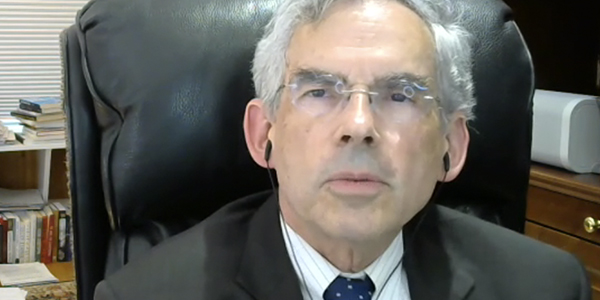The elimination of coal-fired electric generation means that New York’s battle against climate change must now focus on natural gas, Columbia Law School’s Michael Gerrard told the Independent Power Producers of New York (IPPNY) in the keynote address at the organization’s 35th annual Fall Conference last week.
“Far and away the largest source of greenhouse emissions in New York state is natural gas, and more of it comes from electricity production than anywhere else,” said Gerrard, a member of the Climate Leadership Council (CLC) and the founder of Columbia’s Sabin Center for Climate Change. “This is a blinking red light.”
The state’s last coal-fired generator, the Somerset plant on Lake Ontario, ended production in March. But while New York has banned fracking within its borders, more than half of its generating capacity is at natural gas-fired power plants, and a recent study concluded that its GHG emissions in 2015 were virtually unchanged from 1990 levels when considering upstream impacts and the role of methane from drilling sites producing the state’s fuel. Methane is about 80 times as potent at trapping heat as CO2 in its first 20 years. (See NY Study Highlights Rising Methane Emissions.)
“The climate reality is that global temperatures will continue to go up until we achieve net-zero [GHG] emissions,” said Gerrard, who spoke in place of his friend and colleague, CLC founder and CEO Ted Halstead, who had died in a hiking accident in Spain the previous week.
Economywide Carbon Tax?
The CLC’s 2017 climate change proposal called for an economywide fee on CO2 emissions starting at $40/ton and increasing by 5% every year, with all the revenue distributed to people in quarterly dividends.
But Congress hasn’t made a serious attempt to address GHG emissions since the failure of the Waxman-Markey cap-and-trade bill in 2009, leaving New York and other states to ratchet up their own efforts to address climate change.
The Climate Leadership and Community Protection Act (CLCPA) signed by New York Gov. Andrew Cuomo in July 2019 set ambitious clean energy goals — 100% zero-emission electricity by 2040 and an 85% cut in emissions by 2050 from 1990 levels — but did not include all the measures that will be needed to reach them.
A bill introduced in the state legislature last year that would impose a $35/ton carbon tax, rising after 11 years to $180, has not made it out of committee after previous failed attempts dating back to the legislature’s 2015-16 session (S3608).
“I’m not holding my breath that we’ll have either a nationwide or a New York state economywide carbon tax,” Gerrard said. He said the most promising initiative in the state may be the joint task force on carbon pricing created by NYISO and the state’s Public Service Commission in 2017, which resulted in a proposal published last December that would have the commission set the social cost of carbon to be used in any state policy.
Electrifying Everything
Gerrard said that while there is no unanimity on this issue, he thinks that FERC has the authority to consider climate change when acting on matters like the NYISO carbon pricing proposal.
“FERC makes its decision based on its view of the public interest, a phrase that appears about 50 times in the Federal Power Act. In the words of current FERC Commissioner Richard Glick, ‘climate change must factor directly into the commission’s permitting responsibilities, which generally require the commission to determine whether the relevant facilities are consistent with the public interest.’ Simply put, it is hard to imagine a consideration more relevant to the public interest than the existential threat posed by climate change,” Gerrard said.
Extreme heat kills more people than does extreme cold, he said, showing a National Weather Service heat index map that indicated extreme danger at 40% humidity and 110 degrees Fahrenheit, the highest temperature on the map.
“They don’t go higher than that, but we’ve seen actual temperatures in the last month that go literally off the charts,” Gerrard said. “The appropriately named Death Valley, Calif., experienced 130 degrees just a couple weeks ago, which may have been the warmest temperature ever recorded on the planet.”
Preventing the atmosphere from warming more than 1.5 degrees Celsius above pre-industrial levels, as recommended by the U.N. Intergovernmental Panel on Climate Change, will require electricity decarbonization, energy efficiency, carbon capture and electrification of transportation and everything else run by fossil fuels, Gerrard said.
Matt Schwall, IPPNY director of market policy and regulatory affairs, asked what the regulatory chances are of FERC approving a New York carbon pricing plan.
“I think it only happens if we have a change in administrations, and a change therefore in the composition of FERC,” Gerrard said. “I think it only happens with strong support from New York state. … If there is all of this support, and it’s clear we’re not going to have federal carbon pricing, there’s a good chance that FERC would approve it.”
Such a ruling could withstand an appellate challenge, he said, “because there is lots of precedent within FERC for considering [GHG] in a variety of contexts.”
Still, he added, surviving the challenge “depends in part on what panel is randomly drawn at the D.C. Circuit [Court of Appeals] to hear it.”




